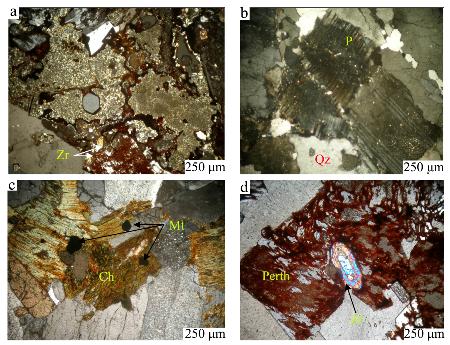El Gharbawy R.I.2, El Feky M.G.1*, El Galy M.M.1, and El Maadawy W.M.1
(1 Nuclear Materials Authority, P.O. Box 030, Maadi, Egypt
2 Faculty of Science, Ain Shams Univeristy, Cairo, Egypt)

Fig. Photomicrographs of uraniferous (altered) monzogranites. a. Vugs filled with hematite, secondary quartz, zircon, iron oxide and radioactive minerals (r), formed after dissolution of quartz and feldspar; b. strained plagioclase (P) with poiklitic texture and interstitial quartz (Qz); c. biotite altered to chlorite (Ch) enclosing magnetite (Mt) grains. Poikilitic intergrowth texture is also encountered; d. zoned and metamicted zircon crystal (Zr) inclosed in hematitized perthite.
Abstract This study is concerned with the radioactivity and mineralogy of the younger granites and pegmatites in the Wadi Haleifiya area, southeastern Sinai Peninsula, Egypt. The area is occupied by metasediments, migmatites, older and younger granites. Most of these rocks, especially granites, are dissected by mafic and felsic dykes as well as pegmatites.
The younger granites are represented by three main varieties: monzogranites, syenogranites and alkali feldspar granites. The monzogranite consists essentially of quartz, plagioclase, potash feldspar and biotite with minor muscovite. Iron oxide, titanite, zircon and allanite are the main accessory minerals. Syenogranite is massive, medium- to coarse-grained and commonly exhibits equigranular and hypidiomorphic textures. It is made up essentially of potash feldspar, quartz, plagioclase and biotite. Iron oxides, allanite, epidote, titanite, and zircon are accessory minerals. The alkali feldspar granite consists mainly of perthite, quartz, alkali amphibole (arfvedsonite and riebekite), biotite, subordinate plagioclase and aegirine. Iron oxide, zircon and apatite are accessory minerals, whereas chlorite and sassurite are secondary minerals.
The altered monzogranite and pegmatite recorded high radioelement contents. The eU reaches up to 120 (av.=82×10-6) in the altered monzogranite and up to 55 (av.=27×10-6) in the pegmatites. The high radioactivity in the altered monzogranite is due to the presence of thorite, uranothorite and metamict zircon. In the pegmatites, it is related to the presence of uranophane, uranothorite, thorite, zircon, samarskite, monazite, xenotime, magnetite, ilmenite, hematite and rutile.
Key words Wadi Haleifiya; younger granite; pegmatite; uranophane; uranothorite; thorite
* Corresponding author, E-mail: mglal_99@hotmail.com
CHINESE JOURNAL OF GEOCHEMISTRY Vol. 30, No. 3, 2011, page 304-316
© Science Press and Institute of Geochemistry, CAS and Springer-Verlag Berlin Heidelberg 2011